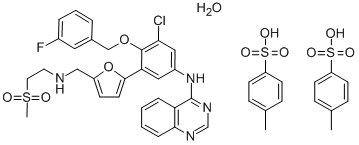
388082-78-8
- Product Name:388082-78-8CAS NO.: 388082-78-8
- Molecular Formula:C41H40ClFN4O11S3
- Purity:99%
- Molecular Weight:
Product Details;
CasNo: 388082-78-8
Molecular Formula: C41H40ClFN4O11S3
Appearance: powder
Delivery Time: In stock
Throughput: 10000|Kilogram|Month
Purity: 99%
| Uses | anticancer |
| Uses | binds to a(1), dopamine, histamine H1, muscarinic, and serotonin type 2 (5-HT2) receptors atypical antipsychotic agent |
| General Description | Lapatinib is available in 250-mg tablets for oral administrationand is used in combination with cabecitabine in thetreatment of breast cancer for those patients that over expressthe type 2 EGF-R and who have previously receivedtaxane, anthracycline, and trastuzumab therapy. The type 2EGF-R is one subtype of this receptor and is also known asHER2 or ErbB-2. The agent is a receptor TK inhibitor targetingthe ErbB-1 and ErbB-2 subtypes. Binding occurs atthe ATP-binding site and thereby prevents phosphorylationand the subsequent activation of other kinase enzymes.ErbB-1 overexpression occurs in approximately27% to 30% of breast cancers, while ErbB-2 is over expressedin 20% to 25% of cases.The agent has demonstratedIC50 values of <0.2μM against ErbB-1 and 2 fromseveral different cancer cell lines and dissociates slowly(t1/2=300 min) from these receptor TKs.The drug isboth a substrate and an inhibitor of the efflux transportersPgp and BCRP. It is also an inhibitor of the hepatic uptaketransporter OATP1B1, which is an organic anion transporter.The absorption of lapatinib is incomplete andvariable after oral administration. The agent is extensivelymetabolized by CYP3A4 and CYP3A5, with minor contributionsfrom CYP2C19 and CYP2C8. Lapatinib inhibitsCYP3A and CYP2C8 at clinically relevant concentrations.The agent is highly (99%) protein bound and eliminatedprimarily in the feces. The half-life of the agent increaseupon repeated dosing, taking 6 days to reach steady statethat gives an effective half-life of 24 hours. The most commonlyseen adverse effects of lapatinib therapy are skinrash and diarrhea. Skin rash is commonly seen with manyof the other TK inhibitors and agents that target ErbB-1.Lapatinib-induced diarrhea is usually mild to moderate.There have been reports of decreases in left ventricularejection fraction associated with the agent, although thisappears to occur only rarely and is reversible upon discontinuationof therapy. |
Relevant Products
-
Ripasudil hydrochloride dihydrateCAS NO.: 887375-67-9
CAS:887375-67-9
-
Benzene,ethenyl-, homopolymer, isotactic
CAS:25086-18-4
-
4-Amino-3-bromobenzonitrileCAS NO.: 50397-74-5
CAS:50397-74-5







